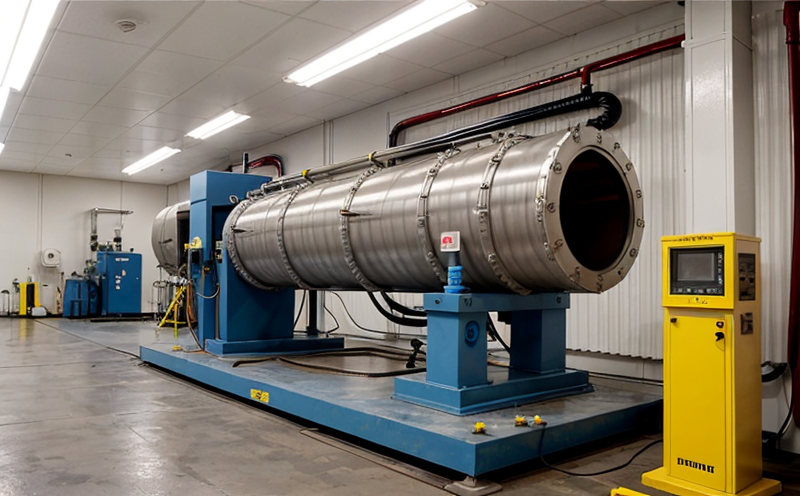ASTM C859 Determination of Oxygen-to-Uranium Ratio in UO₂
The ASTM C859 standard method is critical for ensuring the quality and consistency of uranium dioxide (UO₂) produced for nuclear fuel applications. This method provides a precise means to determine the oxygen-to-uranium ratio, which directly influences the performance characteristics of reactor-grade UO₂. The ratio determines the degree of oxidation, a key factor in the material's stability and reactivity under operational conditions.
The ASTM C859 procedure involves measuring the mass change during heating of the UO₂ sample at specific temperatures to determine the oxygen content. This is achieved using thermogravimetric analysis (TGA), which quantifies changes in mass as a function of temperature. The process requires careful preparation and handling, ensuring that the sample remains uncontaminated by external factors such as moisture or other elements.
The accuracy of ASTM C859 is paramount for nuclear fuel safety and efficiency. Variations in the oxygen-to-uranium ratio can lead to changes in the material's thermal properties, mechanical strength, and reactivity with water, all of which are critical attributes in reactor core design and operation.
The standard specifies a range of temperatures and heating rates that must be strictly adhered to for accurate results. The method is sensitive to even minor deviations in temperature control and atmosphere conditions. Therefore, it is essential to use high-precision TGA equipment capable of maintaining stable and controlled environments during the test.
In addition to the technical aspects, ASTM C859 also emphasizes the importance of sample preparation. The UO₂ powder must be thoroughly dried before analysis to prevent inaccuracies due to water content. Proper grinding techniques are crucial for ensuring a homogeneous mixture that represents the true composition of the material being tested.
The results from ASTM C859 testing are used by quality managers and compliance officers to ensure adherence to strict nuclear fuel specifications. For R&D engineers, this method is invaluable in optimizing production processes and developing new materials with improved performance characteristics. Procurement teams rely on these data points to verify the authenticity and quality of UO₂ purchased from suppliers.
The ASTM C859 standard ensures that all participants in the nuclear fuel supply chain adhere to a common set of procedures, enhancing reliability and consistency across the industry. By adhering to this method, stakeholders can ensure that the materials used in reactor cores meet the highest safety and performance standards.
Why It Matters
The oxygen-to-uranium ratio is a critical parameter for ensuring the safe and efficient operation of nuclear reactors. Variations in this ratio can lead to changes in material properties that may compromise reactor performance or safety. ASTM C859 provides a standardized approach to measuring this ratio, thereby facilitating consistent quality across different production batches.
Accurate oxygen-to-uranium ratios are essential for optimizing fuel efficiency and reducing operational costs. Ensuring the correct ratio helps prevent unwanted chemical reactions that could lead to fuel failures or other safety issues during reactor operation. This standard is vital for maintaining the integrity of nuclear fuel, which directly impacts public safety.
By adhering to ASTM C859, manufacturers can demonstrate compliance with international standards and specifications, thereby enhancing their reputation in the global market. The results from this test are also crucial for regulatory bodies to verify that nuclear fuels meet stringent quality requirements before being approved for use in reactors.
Applied Standards
The ASTM C859 standard is widely recognized and applied across the nuclear fuel industry. It is specifically designed for the determination of oxygen-to-uranium ratios in uranium dioxide (UO₂) powders intended for use as nuclear fuel. This method ensures that materials meet specific quality criteria, which are critical for reactor safety and performance.
The standard specifies detailed procedures for sample preparation, including drying techniques, grinding methods, and handling protocols to prevent contamination. It also outlines the precise conditions required for thermogravimetric analysis (TGA) to ensure accurate measurements of oxygen content. Compliance with ASTM C859 is essential for ensuring that UO₂ meets international standards and specifications.
International acceptance of ASTM C859 underscores its importance in the nuclear fuel industry. Many countries have adopted this standard as part of their regulatory frameworks, recognizing its role in enhancing safety and reliability in reactor operations.
International Acceptance and Recognition
The ASTM C859 method has gained widespread recognition and acceptance within the nuclear fuel industry. It is widely used by manufacturers, quality control departments, and regulatory agencies around the world to ensure that uranium dioxide (UO₂) meets stringent quality standards.
Many countries have incorporated ASTM C859 into their national regulations and guidelines for nuclear fuel production. This standard is particularly important in regions with active nuclear power programs, where consistent material quality is critical for reactor safety and performance.
The method's international acceptance is further enhanced by its alignment with other relevant standards such as ISO 17634, which provides guidelines for the chemical analysis of uranium. By adhering to ASTM C859, manufacturers can ensure that their products meet not only local but also global quality benchmarks.
The recognition and acceptance of ASTM C859 by international bodies highlight its significance in the nuclear fuel industry. Its widespread adoption demonstrates the standard's reliability and effectiveness in ensuring consistent material quality across different production facilities.





